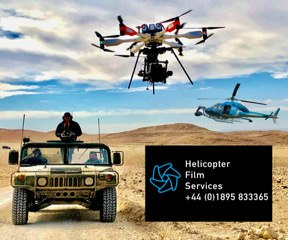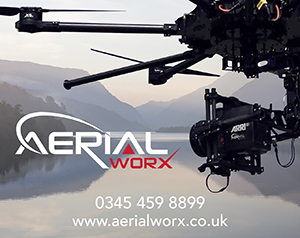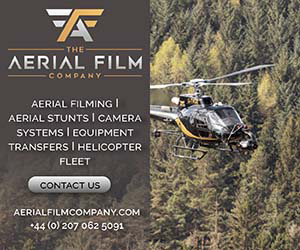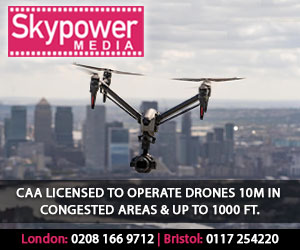Broadcast News
01/07/2015
A Guide To Aerial Filming
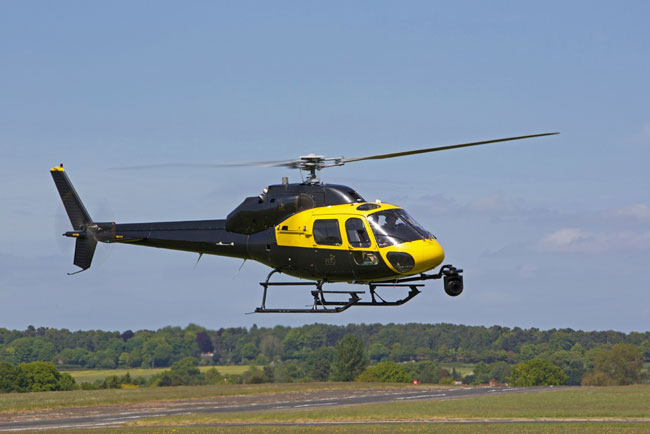
Preparation is everything when it comes to aerial filming, so here's a few pointers to help you plan a successful shoot, courtesy of PDG Helicopters.
Safety
Your safety must always come first, so when you're choosing a helicopter operator you should first ensure they hold a valid Air Operators Certificate issued by the CAA and conform to the exacting standards for commercial helicopter operation.
Credibility
Ensure that the helicopter company you choose is professional and has the required skills and experience to deliver the highest standards of aerial filming. Ask for a TV and movies credit list and try to view some of their past work.
Aircraft
Helicopters are the ideal platform to deliver the camera and capture amazing aerial shots but your choice of helicopter is important as this can limit the height and location of your filming. A twin engine helicopter will generally get you closer to the action and allow you to fly lower over a city or fly further over water, whereas a single engine machine will have greater limitations in such areas.
Aircraft type and size should also be a consideration, as you may need room for your crew members and their equipment. Small four-seat helicopters may cost less but your comfort, safety and quality of filming could be at risk if it's overloaded.
Cameras
Gyro-stabilised camera systems offer a massive advantage over handheld cameras. The initial hire cost of a gyro stabilised system may seem expensive when compared to these options but the restricted views and inability to use a long lens combined with the vibration means it could take you much longer to capture a decent shot. Compare this to a nose mounted 5-axis gyro-stabilised system with long lens, the gyro system will get you the shot in a fraction of the time and so deliver far more material in the time that you have. Always use the highest resolution possible as this can extend the life of the footage and allow you to use it for future projects.
Locations
Discuss your choice of filming locations with your helicopter operator. The locations may seem perfect to you, but flight restrictions might be in place. The helicopter operator will generally know where they can fly and in some cases they can apply for special exemptions from the CAA.
Communication
If you are planning to film somebody on the ground or in a vehicle, it's a massive benefit to have air band radios. These operate on a different band to normal 2-way radios and will allow communication between the aircraft and the ground crew through the aircraft radios and ultimately make the hole process of filming much easier and save valuable flight time.
Ground Support
When filming for long periods in remote locations it may be wise having a portable fuel bowser on site for the aircraft. This can save both time and money if the closest airfield with fuel is more than 30 minutes flight time away.
Crew
On board the helicopter you'll obviously need a pilot and camera operator and normally a director. Try and limit the crew to this, adding extra people to the flight will only reduce the fuel load that the aircraft can carry which reduces its endurance and could mean you need to break off filming to go and refuel resulting in extra costs through landing charges. Avoid having people onboard who suffer from travel sickness. The results are obvious and can literally stop the flying and ruin the filming.
Briefing
Prior to the aircraft going anywhere, always sit down with the pilot and camera operator to discuss all aspects of the filming and flight. A story board is great but not essential, but at the very least make sure you have a list of all the shots you need and prioritise them to ensure you get the most important shots. Should you run out of time, the least important shots can be sacrificed.
Onboard the helicopter
Once you're in the air get the camera rolling and take every opportunity to capture footage. An experienced camera operator will keep offering up shots for GV's between locations and while on route you can discuss the next shot. During filming its important to keep the crew communication going, so direct the shot or provide feedback (good or bad) and if the shot isn't working you need to say so that no time is wasted. Before moving on to the next location make sure you have everything you need and tick it off your list. The pilot should keep you informed of how much time you've used so that you can control how much time you spend capturing each shot.
Have a great shoot!
www.pdghelicopters.com
Safety
Your safety must always come first, so when you're choosing a helicopter operator you should first ensure they hold a valid Air Operators Certificate issued by the CAA and conform to the exacting standards for commercial helicopter operation.
Credibility
Ensure that the helicopter company you choose is professional and has the required skills and experience to deliver the highest standards of aerial filming. Ask for a TV and movies credit list and try to view some of their past work.
Aircraft
Helicopters are the ideal platform to deliver the camera and capture amazing aerial shots but your choice of helicopter is important as this can limit the height and location of your filming. A twin engine helicopter will generally get you closer to the action and allow you to fly lower over a city or fly further over water, whereas a single engine machine will have greater limitations in such areas.
Aircraft type and size should also be a consideration, as you may need room for your crew members and their equipment. Small four-seat helicopters may cost less but your comfort, safety and quality of filming could be at risk if it's overloaded.
Cameras
Gyro-stabilised camera systems offer a massive advantage over handheld cameras. The initial hire cost of a gyro stabilised system may seem expensive when compared to these options but the restricted views and inability to use a long lens combined with the vibration means it could take you much longer to capture a decent shot. Compare this to a nose mounted 5-axis gyro-stabilised system with long lens, the gyro system will get you the shot in a fraction of the time and so deliver far more material in the time that you have. Always use the highest resolution possible as this can extend the life of the footage and allow you to use it for future projects.
Locations
Discuss your choice of filming locations with your helicopter operator. The locations may seem perfect to you, but flight restrictions might be in place. The helicopter operator will generally know where they can fly and in some cases they can apply for special exemptions from the CAA.
Communication
If you are planning to film somebody on the ground or in a vehicle, it's a massive benefit to have air band radios. These operate on a different band to normal 2-way radios and will allow communication between the aircraft and the ground crew through the aircraft radios and ultimately make the hole process of filming much easier and save valuable flight time.
Ground Support
When filming for long periods in remote locations it may be wise having a portable fuel bowser on site for the aircraft. This can save both time and money if the closest airfield with fuel is more than 30 minutes flight time away.
Crew
On board the helicopter you'll obviously need a pilot and camera operator and normally a director. Try and limit the crew to this, adding extra people to the flight will only reduce the fuel load that the aircraft can carry which reduces its endurance and could mean you need to break off filming to go and refuel resulting in extra costs through landing charges. Avoid having people onboard who suffer from travel sickness. The results are obvious and can literally stop the flying and ruin the filming.
Briefing
Prior to the aircraft going anywhere, always sit down with the pilot and camera operator to discuss all aspects of the filming and flight. A story board is great but not essential, but at the very least make sure you have a list of all the shots you need and prioritise them to ensure you get the most important shots. Should you run out of time, the least important shots can be sacrificed.
Onboard the helicopter
Once you're in the air get the camera rolling and take every opportunity to capture footage. An experienced camera operator will keep offering up shots for GV's between locations and while on route you can discuss the next shot. During filming its important to keep the crew communication going, so direct the shot or provide feedback (good or bad) and if the shot isn't working you need to say so that no time is wasted. Before moving on to the next location make sure you have everything you need and tick it off your list. The pilot should keep you informed of how much time you've used so that you can control how much time you spend capturing each shot.
Have a great shoot!
www.pdghelicopters.com
More Aerial Filming Stories
31/01/2023
Flying Features Relies On LiveU
For the third year in a row, the Santos Tour Down Under cycling race was broadcast live from the sky by Australian aerial filming company Flying Featu
Flying Features Relies On LiveU
For the third year in a row, the Santos Tour Down Under cycling race was broadcast live from the sky by Australian aerial filming company Flying Featu
02/06/2017
Live Video Streaming From Drones
Drones provide a mechanism for streaming compelling video that other methods cannot compete with, either from an infrastructure or cost prospective. W
Live Video Streaming From Drones
Drones provide a mechanism for streaming compelling video that other methods cannot compete with, either from an infrastructure or cost prospective. W
26/04/2017
360 Design Announce Flying EYE
360 Designs has announced the launch of Flying EYE, a groundbreaking, 6K, broadcast quality, live streaming VR drone. According to the company the ann
360 Design Announce Flying EYE
360 Designs has announced the launch of Flying EYE, a groundbreaking, 6K, broadcast quality, live streaming VR drone. According to the company the ann
12/04/2017
Festival Recognition For Shetland My Land, My Home
Article contributed by Thomas Haywood, from Thomas Haywood Aerial Photography. Recently, I entered Shetland My Land, My Home into several film festiva
Festival Recognition For Shetland My Land, My Home
Article contributed by Thomas Haywood, from Thomas Haywood Aerial Photography. Recently, I entered Shetland My Land, My Home into several film festiva
31/03/2017
Drone Use In Construction Industry - Part 1
In the first of a two-part report into drones and construction, Jim Meehan, an aerial imaging specialist at SkyHeld Cameras, asks if data quality or s
Drone Use In Construction Industry - Part 1
In the first of a two-part report into drones and construction, Jim Meehan, an aerial imaging specialist at SkyHeld Cameras, asks if data quality or s
31/03/2017
Drone Use In Construction Industry - Part 2
In the second of a two-part report into drones and construction Jim Meehan, aerial imaging specialist at SkyHeld Cameras, rounds up the reasons that d
Drone Use In Construction Industry - Part 2
In the second of a two-part report into drones and construction Jim Meehan, aerial imaging specialist at SkyHeld Cameras, rounds up the reasons that d
30/03/2017
GoPro Karma Now Available In The UK
GoPro have announced that it's complete Karma system is now available at selected online and high street retailers. Karma features a compact design an
GoPro Karma Now Available In The UK
GoPro have announced that it's complete Karma system is now available at selected online and high street retailers. Karma features a compact design an
08/03/2017
Hovercam Goes On The Hunt For Sharks
Hovercam's Benet Allen went shark-baiting with the team from ITV's Fishing Impossible... They told us it was going to be straightforward, if a bit sme
Hovercam Goes On The Hunt For Sharks
Hovercam's Benet Allen went shark-baiting with the team from ITV's Fishing Impossible... They told us it was going to be straightforward, if a bit sme
23/01/2017
Producing Live UHD/4K Aerial Footage On Budget
Just a few years ago, the only option of producing professional, dynamic live aerial footage was renting a turbine driven helicopter equipped with a h
Producing Live UHD/4K Aerial Footage On Budget
Just a few years ago, the only option of producing professional, dynamic live aerial footage was renting a turbine driven helicopter equipped with a h
20/01/2017
BFV's Big Interview: BeyondHD
With 20 years specialising in aerial and vehicle-based stabilised remote head filming equipment and crew hire – from manned aerial filming and class l
BFV's Big Interview: BeyondHD
With 20 years specialising in aerial and vehicle-based stabilised remote head filming equipment and crew hire – from manned aerial filming and class l





